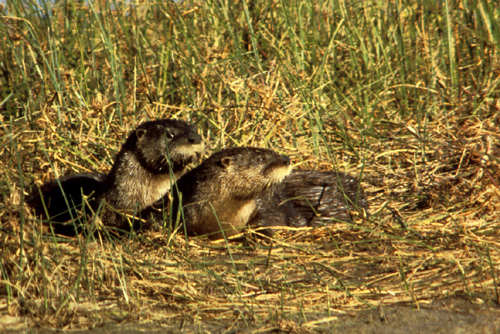Northern River Otters are aquatic members of the weasel family that live in Connecticut. Their bodies are long and streamlined and their legs short. They have webbed feet equipped with claws. Otters have broad flattened heads and prominent whiskers. Their tails are furred and muscular, broad at the base and narrow towards the tip. The tails are 12 to 20 inches long. River Otters have dark brown fur that is paler underneath, and there is often silver at their throat. They weigh 11 to 30 lbs.
Northern River Otters range through the northwestern, northeastern, and southeastern corners of the continental US, through the Great Lakes region, and through much of Canada and Alaska. The Connecticut River is home to a healthy and stable population. River Otters live in and by water and are found along rivers, streams, lakes, ponds and in marshes. They are active in the day or the night, and are active year-round.
River Otters are carnivorous. They dine on fish, small mammals, crayfish, shellfish, aquatic insects and amphibeans. River Otters will often keep open several holes in the ice open over the winter for access to fishing.
Mating takes place in March and April, shortly after the annual litter of 1-5 young are born in February or March. Implantation of the embryos is delayed 9 to 10 months so that their next litter is born the following spring. River Otter females care for the young. Some sources say father Otters begin helping to care for the young when they are older. Otters use old muskrat or beaver dens or a natural hollow in a log. Dens are used as homes and as places to raise young.
Otters are sociable although males may fight during breeding season. River Otters are extremely playful animals. Groups will play together or they will play by themselves. They will toss and catch pebbles, romp, slide down snowbanks or down mudbanks, body surf in current- all apparently for the sheer joy of it.
River Otters are graceful and strong swimmers, clearly built for water. They have ear and nose valves to exclude water. Their fur is waterproof. They can dive 60 feet, hold their breath for up to 4 minutes, and swim underwater for distances of 1/4 mile. Top swimming speed can reach 7 mph. They can move about on land in a lope and can achieve 15 to 18 mph. They will take advantage of snow or ice to travel more quickly by sliding along on their bellies (as well as doing so for the fun of it). River Otters usually move from place to place frequently and sometimes travel overland for some time in order to reach the next water source. The territory used by an otter can be 50 miles of shoreline.
Neat Facts
Otters tend to eat up small fish in entirety from head to tail. The undigestible scales and bones harmlessly pass through their digestive system and are deposited as scat.
Young otters will often follow their mother about on land or while swimming in single file.
